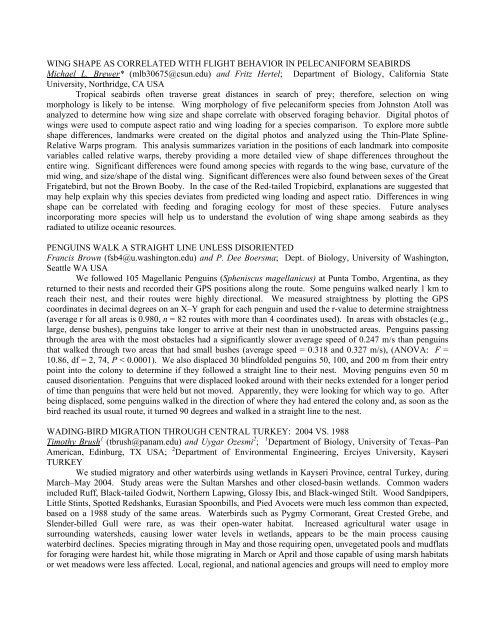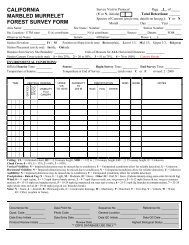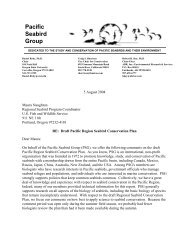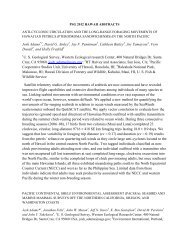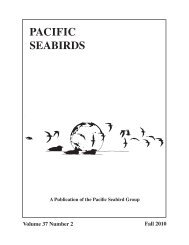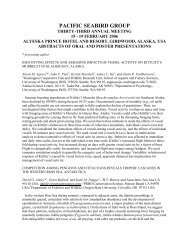abstracts of oral and poster presentations - Pacific Seabird Group
abstracts of oral and poster presentations - Pacific Seabird Group
abstracts of oral and poster presentations - Pacific Seabird Group
Create successful ePaper yourself
Turn your PDF publications into a flip-book with our unique Google optimized e-Paper software.
WING SHAPE AS CORRELATED WITH FLIGHT BEHAVIOR IN PELECANIFORM SEABIRDS<br />
Michael L. Brewer* (mlb30675@csun.edu) <strong>and</strong> Fritz Hertel; Department <strong>of</strong> Biology, California State<br />
University, Northridge, CA USA<br />
Tropical seabirds <strong>of</strong>ten traverse great distances in search <strong>of</strong> prey; therefore, selection on wing<br />
morphology is likely to be intense. Wing morphology <strong>of</strong> five pelecaniform species from Johnston Atoll was<br />
analyzed to determine how wing size <strong>and</strong> shape correlate with observed foraging behavior. Digital photos <strong>of</strong><br />
wings were used to compute aspect ratio <strong>and</strong> wing loading for a species comparison. To explore more subtle<br />
shape differences, l<strong>and</strong>marks were created on the digital photos <strong>and</strong> analyzed using the Thin-Plate Spline-<br />
Relative Warps program. This analysis summarizes variation in the positions <strong>of</strong> each l<strong>and</strong>mark into composite<br />
variables called relative warps, thereby providing a more detailed view <strong>of</strong> shape differences throughout the<br />
entire wing. Significant differences were found among species with regards to the wing base, curvature <strong>of</strong> the<br />
mid wing, <strong>and</strong> size/shape <strong>of</strong> the distal wing. Significant differences were also found between sexes <strong>of</strong> the Great<br />
Frigatebird, but not the Brown Booby. In the case <strong>of</strong> the Red-tailed Tropicbird, explanations are suggested that<br />
may help explain why this species deviates from predicted wing loading <strong>and</strong> aspect ratio. Differences in wing<br />
shape can be correlated with feeding <strong>and</strong> foraging ecology for most <strong>of</strong> these species. Future analyses<br />
incorporating more species will help us to underst<strong>and</strong> the evolution <strong>of</strong> wing shape among seabirds as they<br />
radiated to utilize oceanic resources.<br />
PENGUINS WALK A STRAIGHT LINE UNLESS DISORIENTED<br />
Francis Brown (fsb4@u.washington.edu) <strong>and</strong> P. Dee Boersma; Dept. <strong>of</strong> Biology, University <strong>of</strong> Washington,<br />
Seattle WA USA<br />
We followed 105 Magellanic Penguins (Spheniscus magellanicus) at Punta Tombo, Argentina, as they<br />
returned to their nests <strong>and</strong> recorded their GPS positions along the route. Some penguins walked nearly 1 km to<br />
reach their nest, <strong>and</strong> their routes were highly directional. We measured straightness by plotting the GPS<br />
coordinates in decimal degrees on an X–Y graph for each penguin <strong>and</strong> used the r-value to determine straightness<br />
(average r for all areas is 0.980, n = 82 routes with more than 4 coordinates used). In areas with obstacles (e.g.,<br />
large, dense bushes), penguins take longer to arrive at their nest than in unobstructed areas. Penguins passing<br />
through the area with the most obstacles had a significantly slower average speed <strong>of</strong> 0.247 m/s than penguins<br />
that walked through two areas that had small bushes (average speed = 0.318 <strong>and</strong> 0.327 m/s), (ANOVA: F =<br />
10.86, df = 2, 74, P < 0.0001). We also displaced 30 blindfolded penguins 50, 100, <strong>and</strong> 200 m from their entry<br />
point into the colony to determine if they followed a straight line to their nest. Moving penguins even 50 m<br />
caused disorientation. Penguins that were displaced looked around with their necks extended for a longer period<br />
<strong>of</strong> time than penguins that were held but not moved. Apparently, they were looking for which way to go. After<br />
being displaced, some penguins walked in the direction <strong>of</strong> where they had entered the colony <strong>and</strong>, as soon as the<br />
bird reached its usual route, it turned 90 degrees <strong>and</strong> walked in a straight line to the nest.<br />
WADING-BIRD MIGRATION THROUGH CENTRAL TURKEY: 2004 VS. 1988<br />
Timothy Brush 1 (tbrush@panam.edu) <strong>and</strong> Uygar Ozesmi 2 ; 1 Department <strong>of</strong> Biology, University <strong>of</strong> Texas–Pan<br />
American, Edinburg, TX USA; 2 Department <strong>of</strong> Environmental Engineering, Erciyes University, Kayseri<br />
TURKEY<br />
We studied migratory <strong>and</strong> other waterbirds using wetl<strong>and</strong>s in Kayseri Province, central Turkey, during<br />
March–May 2004. Study areas were the Sultan Marshes <strong>and</strong> other closed-basin wetl<strong>and</strong>s. Common waders<br />
included Ruff, Black-tailed Godwit, Northern Lapwing, Glossy Ibis, <strong>and</strong> Black-winged Stilt. Wood S<strong>and</strong>pipers,<br />
Little Stints, Spotted Redshanks, Eurasian Spoonbills, <strong>and</strong> Pied Avocets were much less common than expected,<br />
based on a 1988 study <strong>of</strong> the same areas. Waterbirds such as Pygmy Cormorant, Great Crested Grebe, <strong>and</strong><br />
Slender-billed Gull were rare, as was their open-water habitat. Increased agricultural water usage in<br />
surrounding watersheds, causing lower water levels in wetl<strong>and</strong>s, appears to be the main process causing<br />
waterbird declines. Species migrating through in May <strong>and</strong> those requiring open, unvegetated pools <strong>and</strong> mudflats<br />
for foraging were hardest hit, while those migrating in March or April <strong>and</strong> those capable <strong>of</strong> using marsh habitats<br />
or wet meadows were less affected. Local, regional, <strong>and</strong> national agencies <strong>and</strong> groups will need to employ more


